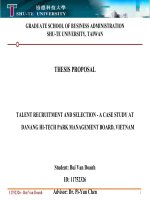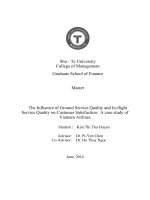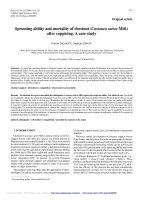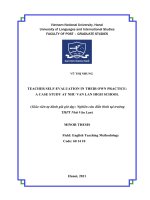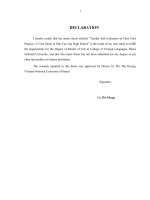Students’ preferences for and Responses to Teacher Written Feedback on Grammatical Errors A case study at Le Quy Don Private Primary School
Bạn đang xem bản rút gọn của tài liệu. Xem và tải ngay bản đầy đủ của tài liệu tại đây (156.4 KB, 9 trang )
Students’ preferences for and Responses to
Teacher Written Feedback on Grammatical
Errors: A case study at Le Quy Don Private
Primary School
Trần Thị Phương Chi
Trường Đại học Ngoại ngữ
Luận văn ThS. Chuyên ngành: English Teaching Methodology; Mã số: 60 14 10
Người hướng dẫn: Pham Minh Tam, M.Ed
Năm bảo vệ: 2013
Keywords: Tiếng Anh; Phương pháp giảng dạy; Ngữ pháp
Content
Chapter 1: INTRODUCTION
This chapter begins with the presentation of the statement of the problem and rationale for
the study. Next, it presents the aims and scopes of the study as well as the research questions to
which the study seeks to find answers. This is followed by a brief description of methodology
used in the present study. Finally, the chapter concludes with a description of the organization of
the thesis.
1.1 Statement of the Problem and Rationale for the Study
Teacher feedback has long been regarded as an essential part in language teaching and
learning because it not only helps students to correct their own mistakes but also enhances more
confidence about their language competences. Feedback may focus on either forms or contents
or both.
It was clearly seen that young learners of English as a foreign language often commit
grammatical errors in their writing. Therefore, teachers’ giving feedback on their errors is
considered to be necessary for students’ proficiency. However, the effectiveness of feedback
does not lie in itself but by many other factors such as students’ preferences for and responses to
the teacher feedback. That is the reason why teachers need to take into account some questions:
“What feedback strategies does a teacher actually use when providing feedback on grammatical
errors”, “Do students like their teachers’ feedback type?”, “How do they react when receiving
feedback?”
Up to now, studies of language education have given considerable attention to the issue
of how to provide feedback on students’ writing (Diab, 2005, Wang, 2010; Katayama; 2007).
Yet, the effectiveness of written feedback on grammatical errors has been under-explored
(Russel, J.M 2003). Some attention has been given to investigate whether certain types of written
feedback may be more effective than the others, but the findings are not inclusive. Additionally,
which feedback strategies would fit the needs of particular students is still questioned.
Addressing these issues will require time and commitment of a number of researchers. The
research being reported in this study contributes to the agenda by investigating the fit between
teachers’ practices, students’ preferences and strategies for handling feedback on their written
work.
Much as important written feedback on grammatical errors is, there have been few
studies comprehensively dealing with the issue. There is also a lack of consensus over such
matters as what feedback strategies is the most effective to correct grammatical errors in
particular context, what feedback types are preferred by students and how students respond when
they receive teacher feedback. Moreover, almost all of the feedback studies on students’
preferences and responses have been conducted in college/ university setting.
Owing to the lack of consensus on the effectiveness of teacher feedback, this study aims
to gain more insights into giving effective feedback by asking what students think, want and do
after they receive teacher feedback.
There is a paucity of research that addresses the elementary context. In Vietnam, a focus
on primary school students is important since they are those who have chances to access English
as a foreign language from the very young ages (7-11). This study is an attempt to examine the
real situation of written feedback on grammatical errors conducted at the Le Quy Don Private
Primary School and to propose some suggestions for the betterment of the current practice.
As most of the past studies have pursued the inquiry of teacher feedback in two general
ways, namely students’ preferences for teacher feedback (Hedgcock & Lefkowitz, 1994; Hiroko,
1994; Leiki, 1999) and students’ responses to teacher feedback (Cohen,1987; Ferris, 1995,
Chiang, 2004), this study follow the similar traits and attempts to find out how students perceive
teacher feedback, what they are concerned about, and what they do after receiving teacher
feedback.
1.2 Objectives of the Study
This research is conducted for the following purposes:
1. To explore the teachers’ written feedback types in respond to students’ grammatical
errors.
2. To investigate the students’ preferences towards different types of feedback
3. To find out the students’ strategies for handling feedback after they have received their
written work
1.3 Research Questions
This study is conducted to answer the following research questions:
1. What are the types of teacher written feedback on the students’ grammatical errors?
2. What are the students’ preferences for different types of teacher feedback on grammatical
errors?
3. How do students handle the feedback they receive?
1.4 Scope of the Study
This study limits itself to the exploration of the types of written feedback on grammatical
errors that were commonly used by the teachers in the study, the students’ preferences for and
responses to each feedback type. Alternative types such as oral corrective feedback by teachers
and peer-to-peer feedback from the students are beyond the scope of this study. The impact of
teacher feedback on learners’ proficiency is also not the objective of the study.
The present research was conducted at a private primary school in Hanoi, with two
teachers and two classes of young learners enrolled in Let’s Go 4 course. Teachers and students
in classes that are not in primary school system are outside the scope of this study.
1.5 Methodology of the Study
This is a case study with the presence of two teachers and two groups of students. The
teachers were teaching English to fourth-graders at Le Quy Don Private Primary School in
Hanoi. Data were then analyzed by means of descriptive statistics to identify the patterns of
feedback employed by the teachers. The students’ preferences were elicited through the
questionnaires and students’ responses to teacher feedback on grammatical errors were collected
from teacher’s interviews.
1.6 Significance of the Study
Providing feedback involves in teachers’ regular practice. Feedback, as a means of
communication from the teachers, needs the responses from the learners in order to enhance its
efficacy. Consequently, the link between teachers’ practice of giving feedback, students’
preferences and students’ responses in primary school context are taken into account in this
study.
Feedback provides students with the information on their performance and learning
progress. Therefore, it is important to know the feedback types preferred by the young learners in
the primary language classroom. Additionally, it offers teachers of English a number of
pedagogical implications in terms of written grammar correction to the learners in this context.
Specifically, teachers can be informed about the effects of different feedback patterns, based on
which they can choose the ones that suit their students’ preferences and work for the types of
feedback that students react positively.
1.7 Organization of the Study
The thesis is composed of 5 chapters.
Chapter 1 presents the research focus and provides the rationale for it as well as its aims, scopes,
method, research questions and the significance of the study.
Chapter 2 reviews the relevant literature, setting the theoretical foundation for the data collection
and analysis
Chapter 3 presents the methodology employed to carry out the present study. This includes a
discussion of the participants, the data collection instruments and the procedures for
data collection and analysis.
Chapter 4 presents the findings of the study with reference to the teacher written feedback
strategies and students’ preferences and response to feedback and also their
relationship.
Chapter 5 gives a brief summary of the main findings, from which pedagogical implications are
derived. This chapter also acknowledges the limitations of the present study and
provides suggestions for further studies.
REFERENCES
Bitchener, J., Young, S., & Cameron, D. (2005). The effect of different types of corrective
feedback on ESL student writing. Journal of Second Language Writing, 14, 191-205.
Bitchener, J., &Knoch, U. (2009).The value of a focused approach to written corrective
feedback. ELT Journal, 63(3), 204–211.
Bitchener, J., & Knoch, U. (2010).Raising the linguistic accuracy level of advanced L2 writers
with written corrective feedback. Journal of Second Language Writing, 19(4), 207–217.
doi:10.1016/j.jslw.2010.10.002
Brannon, L., & Knoblauch, C. H. (1982). On students’ rights to their own texts: A model of
teacher response. College Composition and Communication, 33(2), 157-166.
Brown, H. Douglas (2004) Principles of Language Learning and Teaching (fifth edition), 216 -
219
Burt, M. K., & Kiparsky, C. (1972). The gooficon: A repair manual for English. Rowley, MA:
Newbury House.
Chandler, J. (2003). The efficacy of various kinds of error feedback for improvement in the
accuracy and fluency of L2 student writing. Journal of Second Language Writing,
12(3), 267–296.
Chaney, S. J. (1999). The effect of error types on error correction for improvement in the
accuracy of L2 student writing. Paper presented at the American
Association of Applied Linguistics Conference, March 11-14, 2000, Vancouver, B. C.
Cohen, A D. & Cavalcanti, M. C. (1990). Feedback on compositions: Teacher and student
verbal reports. In B. Kroll (Ed.), Second Language Writing (pp. 155-177). Cambridge:
Cambridge University Press.
Condelli, L. & Wrigley, H.S. (2004). Real world research: Combining qualitative and
quantitative
Creswell, J. (1998). Research design: Qualitative, quantitative, and mixed methods approaches
(2nd ed.). Thousand Oaks, CA: Sage. research for adult ESL. [Word document]
Retrieved from www.leslla.org/files/resources/RealWorldResearch.doc
Diab, R. L. (2005). Teachers’ and students’ beliefs about responding to ESL writing: A case
study. TESL Canada Journal, 23(1), 28–42.
Fathman, A K. & Whalley, E. (1990). Teacher response to student writing: focus on form
versus content. In B. Kroll (Ed.), Second Language Writing (pp. 178-190). Cambridge:
Cambridge University Press.
Ferris, D. R. (1997). The influence of teacher commentary on student revision. TESOL
Quarterly, 31, 315-339.
Ferris, D. R., Chaney, S. J., Komura, K., Roberts, B. J., & McKee, S. (2000, March).
Perspectives, problems, and practices in treating written error. Colloquium presented at
TESOL Convention, Vancouver, BC.
Ferris, D.R., & Roberts, B. (2001). Error feedback in L2 writing classes how explicit does it
need to be? Journal of Second Language Writing, 10, 161-184.
Ferris, D. (2003). Response to student writing: implications for second language students.
Mahwah, NJ : Lawrence Erlbaum.
Ferris, D. (2009). Responding to writing. In B. Kroll, Exploring the Dynamics of Second
Language Writing. (p. 122). New York City, NY: Cambridge University Press.
Ferris, D., Pezone, S., Tade, C., & Tinti, S. (1997). Teacher commentary on student writing:
Descriptions and implications. Journal of Second Language Writing, 6, 155-182.
Ferris, D., & Hedgcock, J. (2009). Teaching ESL composition. New York City, NY: Routledge.
Fraenkel, J. R. & Wallen, N. E. (2000). How to design & evaluate research in education. (4th
ed.) Boston, MA: McGraw-Hill.
Hedgcock, J., & Lefkowitz, N. (1994). Feedback on feedback: Assessing learner receptivity to
teacher response in L2 composing. Journal of Second Language Writing, 3, 141–163.
Hendrickson, J. M. (1978). Error correction in foreign language teaching: Recent theory,
research, and practice. Modern Language Journal, 62, 387–398.
Hong, P. C. (2003). Investigating teachers’ and secondary students’ preferences towards direct
or indirect feedback on students’ writing: Which way is more helpful. [Online]
Available: www.2.ied.edu.hk/mentoring/wals08/download.asp?code=057&ptype
Hyland, F. (1998). The impact of teacher written feedback on individual writers. Journal of
Second Language Writing, 7, 255-286.
Hyland, F. (2003). Focusing on Form: Student Engagement with Teacher Feedback. System,
31(2), 217-230.
Lalande, J.F. 1982. “Reducing composition errors: An experiment”. Modern Language Journal
66 (2): 140-149.
Larsen-Freeman, D., M. Long, (1991) An Introduction to Second Language Acquisition
Research, Longman
Lee, N., (1990) Notions of “Error” and Appropriate Corrective Treatment, Hong Kong Papers
in Linguistics and Language Teaching 13
Lee, I. (1997). ELS learners’ performance in error correction in writing. System, 25, 465-477.
Lee, I. (2003). L2 writing teachers’ perspectives, practices and problems regarding error
feedback. Assessing Writing, 8(3), 216–237.
Lee, I. (2004). Error correction in L2 secondary writing classrooms: The case of Hong Kong.
Journal of Second language Writing, 13, 285-312.
Leki, I. (1991). The preferences of ESL students for error correction in college-level writing
classes.
Foreign Language Annals, 24, 203–218.
Long, M. (1991) Focus on form: A design feature in language teaching methodology. In K. de
Bot, R. B. Ginsberg, & C. Kramsch (Eds.), Foreign language research in cross-cultural
perspective (pp. 39– 52). Amsterdam: Benjamins.
Lyster, R. 1998. “Recasts, repetition, and ambiguity in L2 classroom discourse”. Studies in
Second Language Acquisition 20(1): 51-81.
Matveev, A. (2002). The advantages of employing quantitative and qualitative methods in
intercultural research: Practical implications from the study of the perceptions of
intercultural communication competence by American and Russian managers.
Retrieved on March 9, 2009 from
Merriam, S. (1998). Qualitative Research and Case Study Applications in Education. San
Francisco: Jossey-Bass Inc. Publishers.
Nunan, D. (1999). Second language teaching and learning. Boston: Heinle & Heinle
Publishers.
Radecki, P. M. & Swales, J. M. (1988). ESL student reaction to written comments on their
written work. System, 16(3), 355-365.
Raimes, A. (1991). Out of the woods: Emerging traditions in the teaching of writing. TESOL
Quarterly, 25, 407-430.
Saiko, H. (1994). Teachers Practices and Students’ Preferences for Feedback on Second
Language Writing: A case study of Adult ESL Learners. TESL Canada Journal.11(2),
46-70
Sheen, Y. (2009). Differential effects of focused and unfocused written correction on the
accurate use of grammatical forms by adult esl learners . System: An International
Journal of Educational Technology and Applied Linguistics, 37(4).
Stake, R. E. (1995). The Art of Case Study Research. Thousand Oaks, CA: Sage Publications.
Van Lier (1988). The classroom and the language learner. New York: Longman
Yin, R. K. (2003). Case study research: Design and methods (3rd ed.). Thousand Oaks, CA:
Sage.
Zamel, V. (1985). Responding to student writing. TESOL Quarterly, 19, 79–97.





